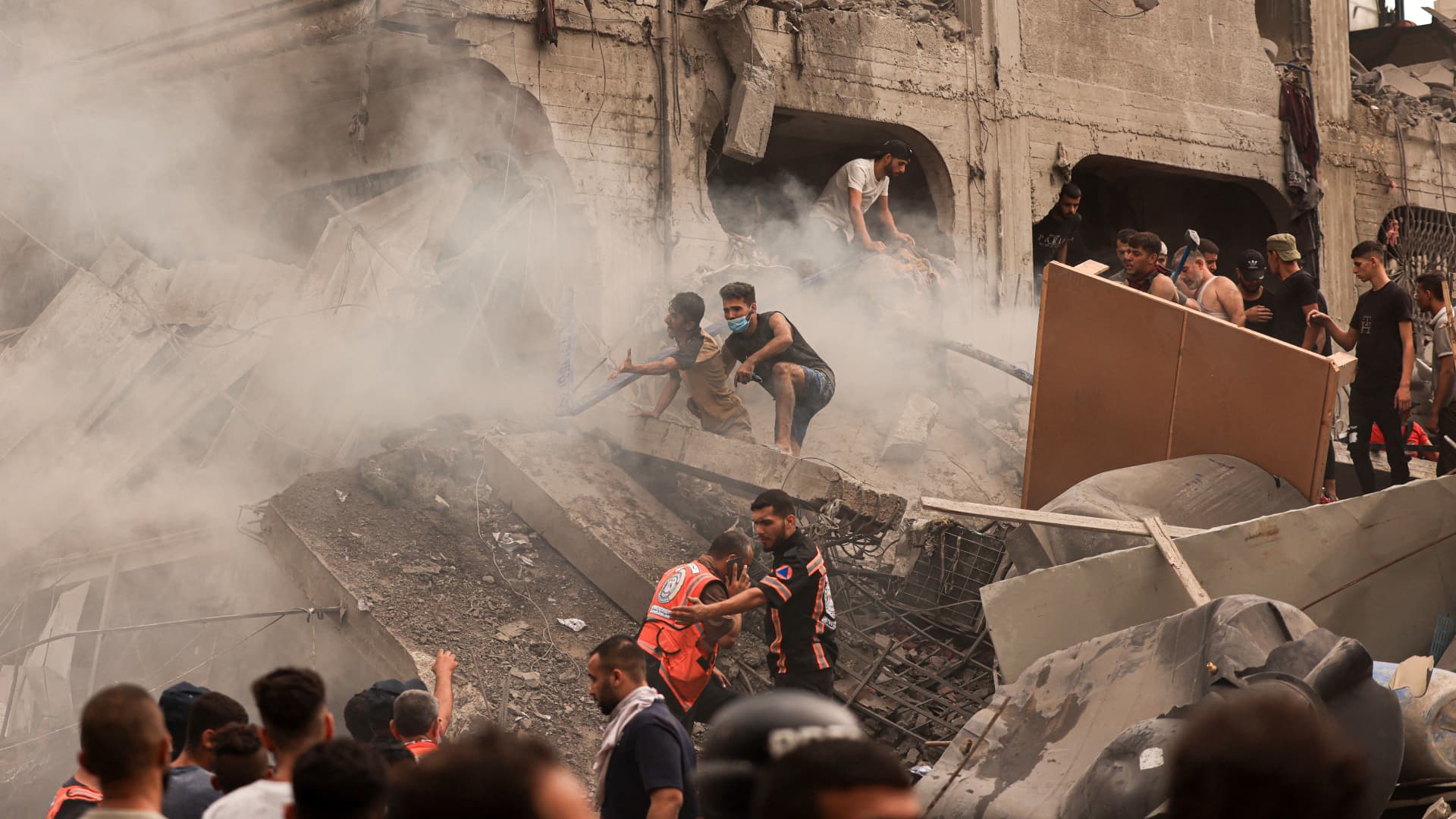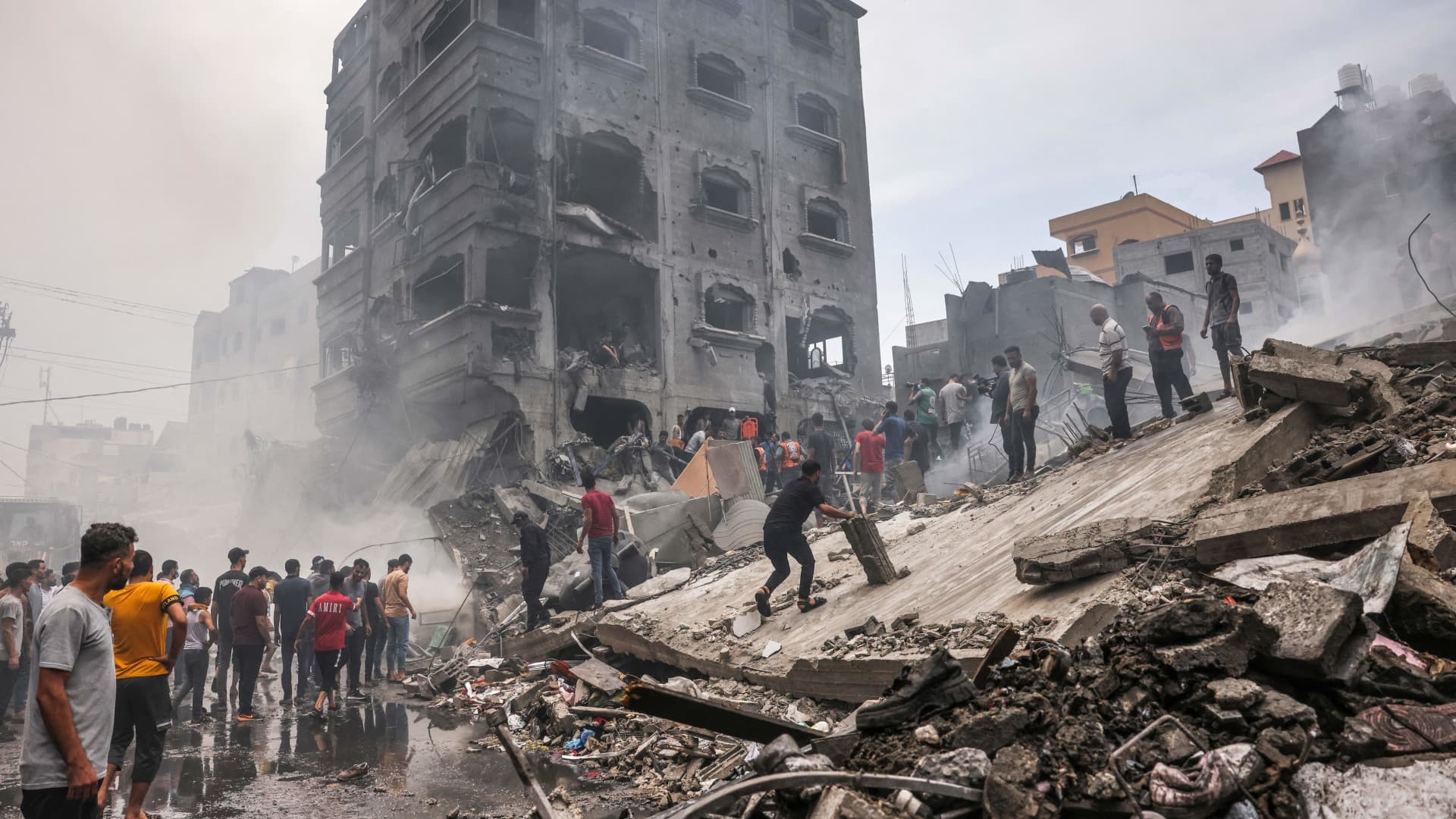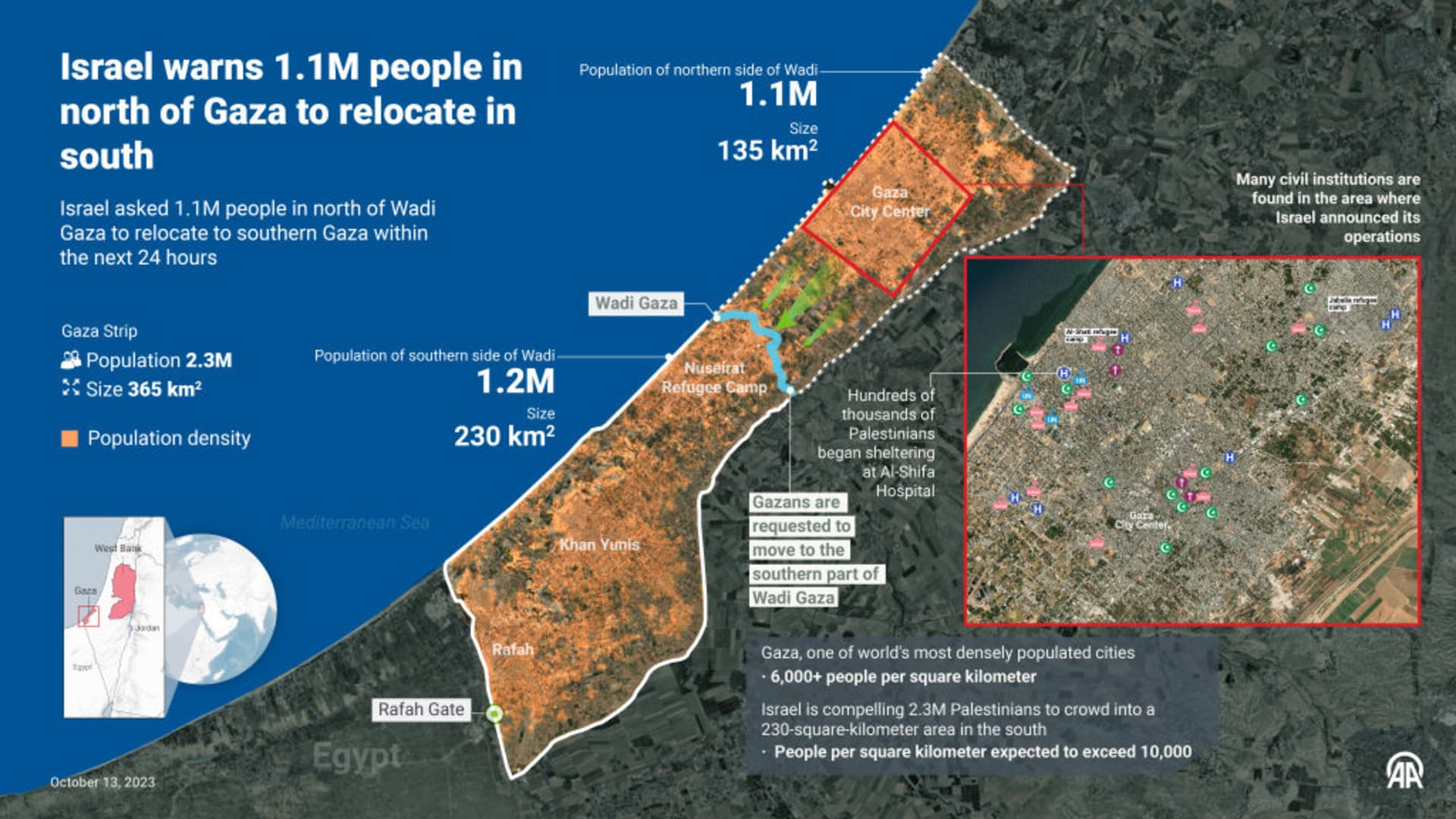
Palestinians walking amid the rubble of destroyed and damaged building in the heavily bombarded city center of Khan Yunis in the southern Gaza Strip on October 10, 2023.
- The Gaza Strip, which some have called "the world's largest open-air prison," is a narrow piece of land between Israel and Egypt.
- More than 2 million Palestinians live in the 140-square-mile enclave, making it one of the most densely populated places on earth.
- In 1947, the newly formed U.N. issued its "Partition Plan for Palestine" which would divide the land — then called Palestine — into an Arab state and a Jewish state.

The Gaza Strip has been the epicenter of heavy bombardment for more than a week after Israel launched retaliatory airstrikes for the unprecedented terror attack by Palestinian militant group Hamas on Oct. 7.
The enclave — a narrow strip of land between Israel and Egypt, next to the Mediterranean Sea — is home to roughly 2.3 million Palestinians and is described as one of the most densely populated places on Earth. The 140-square-mile region is roughly the size of Philadelphia.
Get top local stories in San Diego delivered to you every morning. Sign up for NBC San Diego's News Headlines newsletter.
The majority of those who live in Gaza are young, with almost 65% of the population under the age of 24.
'World's largest open-air prison'
Since 2007, Israel has imposed an air, land and sea blockade on the Gaza Strip, saying the move is necessary to safeguard the country from Hamas' attacks. Gaza is surrounded by concrete walls and barbed wire fences.
Money Report
Palestinians are prohibited from entering or leaving the territory except in extremely rare cases such as "urgent, life-threatening medical conditions," according to Israeli human rights group B'Tselem. Foreign citizens are not subjected to the same restrictions. Human rights groups have described it as "the world's largest open-air prison."
Its economy has been crippled by the strict restrictions on the movement of individuals. Gaza's unemployment rate is above 40%, and 63% of Gazans are deemed food insecure, according to the U.N., with no reliable access to affordable, nutritious food. Additionally, about 80% of Gaza's residents have been reliant on some sort of international aid.
Further exacerbating the humanitarian situation, Israel ordered a total siege of Gaza following Hamas' Oct. 7 terror attack, cutting off food, water and electricity supplies which the enclave depends mostly on Israel for. The United Nations' relief agency in the area (UNRWA) on Sunday warned that fresh water is running out in Gaza. Last Wednesday, its only power plant ran out of fuel.
The World Health Organization warned Thursday that the health system in the Gaza Strip is at "a breaking point," emphasizing that hospitals only have a few hours of electricity each day.
"The humanitarian situation in Gaza was already quite dire after 16 years of Israel's crushing closure. But we're now descending to depths we simply haven't seen," Omar Shakir, a director at Human Rights Watch, told CNBC.
Who controls it?
The Gaza Strip is one of two designated Palestinian territories, the other being the West Bank. It is divided into five governorates: Gaza City, North Gaza, Rafah, Deir el-Balah and Khan Younis.
In 1947, the newly formed U.N. issued its "Partition Plan for Palestine" which would divide the land — then called Palestine — into an Arab state and a Jewish state, to accommodate the desire for a Jewish homeland and the migration of hundreds of thousands of Jewish people from all over the world.
This came against the will of the local Palestinian Arab population and surrounding Arab states.

Following the creation of the state of Israel in 1948 and the subsequent Arab-Israeli war, Israel seized land from the Palestinian Arab-allocated state and ended up with 77% of the total territory. More than half of the Palestinian Arab population was expelled or fled as refugees to Gaza, the West Bank and neighboring countries.
Gaza was under the control of Egypt from 1948 until 1967. Israel subsequently gained control of and occupied the Gaza Strip and the West Bank following its victory in the 1967 Six-Day War against Arab neighbors Egypt, Jordan and Syria. The United Nations classifies Israel as an occupier state over the Palestinian territories.
Fast forward to 2006, and Hamas emerged victorious in Gaza's elections against its rival, the Fatah party. It has been in control of Gaza since. No elections have been held thereafter and Hamas maintains political control.
Hamas, which has been designated a terrorist organization by the U.S. and many other countries, is dedicated to the establishment of an independent Islamic state in historical Palestine. It does not recognize Israel and has demanded that the latter end Gaza's blockade and cease its occupation of the Palestinian territories.
For many years Hamas called for the destruction of Israel, but issued a new charter in 2017 in what was seen as an attempt to moderate its image. It removed the language around Israel's destruction but still calls for all of historic Palestine — which includes Israel — to be liberated.
Hamas is one of two major political forces in the Palestinian territories, the other being Fatah, which was previously known as the Palestinian National Liberation Movement. Fatah retains control of the Palestinian National Authority in the Israeli-occupied West Bank.
Between 2008 and 2023 before the current conflict, Israeli airstrikes had killed 6,407 Palestinians in the occupied territories, 5,360 of whom were in Gaza, according to the U.N. Over the same period, 308 Israelis were killed.
Evacuation
Last Friday, the Israel Defense Forces, or IDF, issued a notice for 1.1 million residents in northern Gaza to evacuate to the south in anticipation of an Israeli ground attack. The U.N. cautioned that it is "impossible" for movement of this scale to take place "without devastating humanitarian consequences."
The Israeli military has said that 600,000 Gazans have evacuated the northern half of the territory. Additionally, about half a million people in Israel have been internally displaced, largely "at their own merit and at their own initiative" in a bid to avoid civilian damage, IDF's Jonathan Conricus said at a news conference.

Israel has been amassing troops along the Gaza border since last Saturday's deadly incursion, in preparation for a possible ground offensive in pursuit of Hamas.
Israeli hostages, meanwhile, are still trapped in Gaza, an act by Hamas that U.N. experts have condemned as a war crime. The organization has strongly criticized the brutal Oct. 7 attack committed by Hamas, and its "deliberate and widespread" killing of innocent civilians.
The U.N. has also condemned Israel's "violent and indiscriminate attacks against Palestinian civilians in Gaza" and a further tightening of the "unlawful blockade."
—CNBC's Natasha Turak and Sam Meredith contributed to this report.
Correction: This story has been updated to accurately reflect who is subjected to controls on movement in Gaza.






